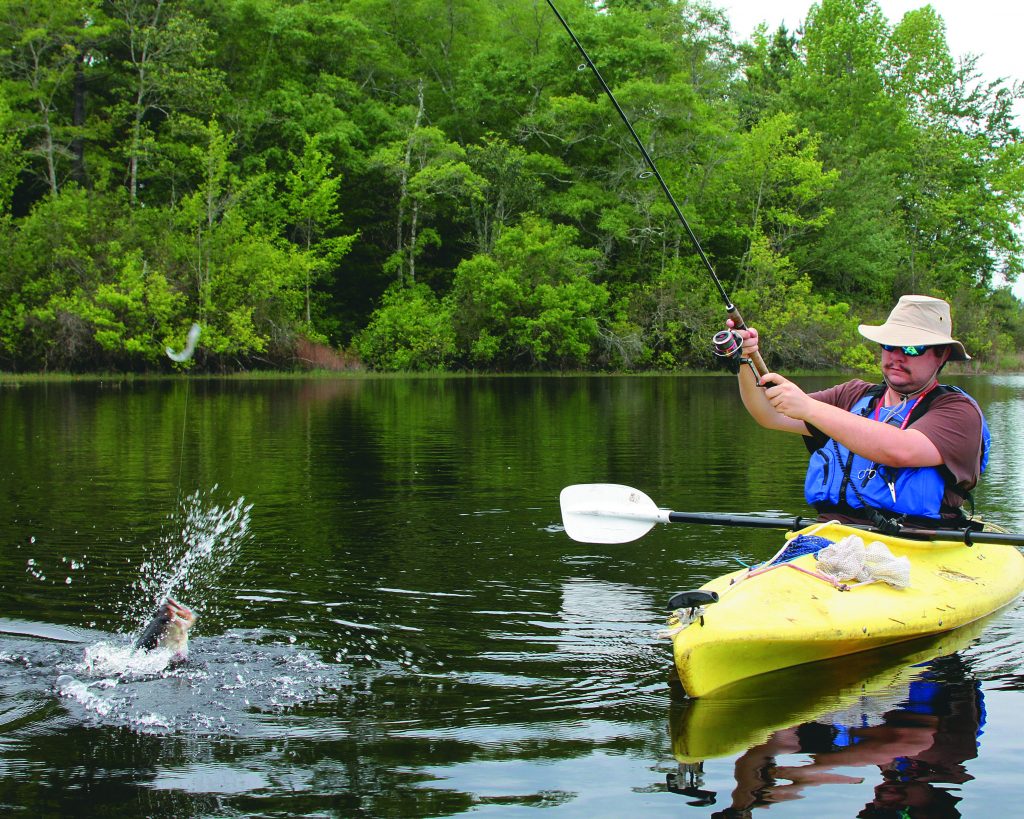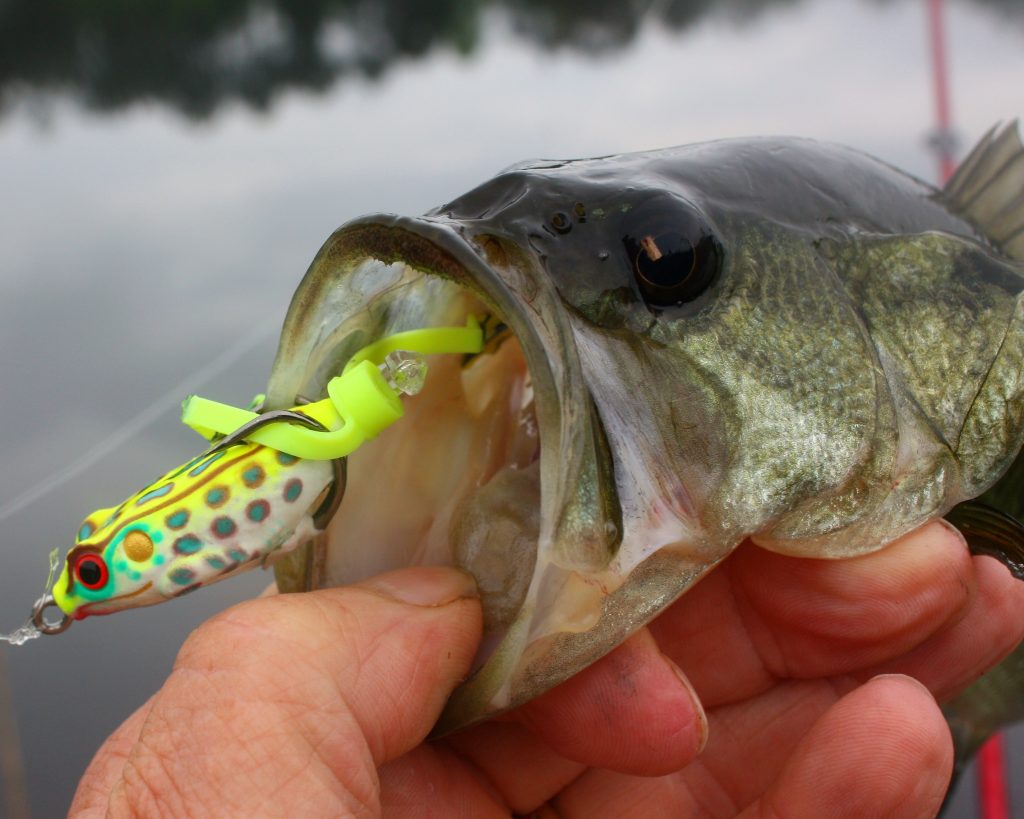When fishing with soft-plastic top-water lures for bass, be prepared for the vicious, nonstop strikes of big mouth bass
The sun is not yet up over the shoreline trees and the very early morning air is very comfortable. On Alabama’s lakes, it’s going to be hot later, but right now the world is fine and it’s the perfect time to try out some top-water lures for bass.
Shadows still cover most of the water. With no breeze, the surface is like a giant pane of glass. Occasionally, something swirls up beneath the patches of thick weed that reach the surface of the water, a result of this summer’s bright sunlight and warm temps.
A cast to the nearest weed mat puts soft-plastic top-water lures for bass at the far edge of the mat. A slow, start-and-stop retrieve brings the lure to the edge of a small open pocket in the weed mat, and then another small hop puts the lure out into the open water.
And then things happen—fast. Something big and green swirls under the lure, and the angler exerts much internal effort to not strike back. As the line comes tight, the angler sets the hook hard. A short, violent battle begins.
After feeling the hook and the pressure of the line, the big bass does what big bass always do in this situation. It dives straight down into the thick, grassy mat of weeds that has sheltered it all summer.
The angler quickly moves his boat to the mat and then right over the mat. With steady pressure the fish, now encased in a ball of weeds and grass, is slowly raised to the surface where the angler grips the lower jaw of the fish and lifts it into the boat.
If plant growth that comes in with a caught fish counted, this bass might be a new world’s record.
Of course, after the weeds are carefully peeled away and only the fish is left, it’s not nearly as big as it felt—still respectable but not a record. A quick photo to prove the catch, and then the bass is released back into its weedy home.
This kind of fishing is addictive, and the only cure is to go catch another one. And maybe a few more.

A kayak is great for bass fishing when using soft-plastic frogs. Photo by Ed Mashburn
The Lures—Got to be a Frog, Right?
Traditionally, this type of fishing is known as “Frog Fishing.” To be sure, there are some super-lifelike soft-plastic top-water lures for bass that look more like frogs than real frogs do. Some of these lifelike frogs come with a hefty price, too. So, as anglers, are we required to use an expensive frog lure for the “Frog Bite?”
Our buddy Captain Jake Davis guides on Lake Guntersville and Guntersville is probably the best-known and most famous lake for top-water frog fishing in the world, so he knows a thing or two about fishing “frogs.”
Concerning the selecting of frog lures, Captain Jake was asked if the lures must closely resemble a real frog.
He laughed and said,” No! Eighty percent of hollow body ‘frog’ lures don’t look like frogs. They just look like a rounded piece of plastic with some sort of tail. If there’s one tail, it’s a rat. If there are two tails, it’s a frog.”
Traditional and much less expensive soft-plastic top-water lures for bass during the late summer/early fall “frog” bite are chunky plastic worms or fluke lures.
“Two colors seem to work best: black and white.”
Two colors seem to work best: black and white. When rigged weedless and weightless, these lures ride over and across surface vegetation, and when allowed to rest they slowly sink.
This is a deadly technique for fishing floating weeds. And the bass don’t care if it looks like a frog or not; they erupt on the lure when it starts to sink.
Anglers will have to seriously set the hook when fishing a weedless rigged plastic worm or fluke. The hook must exit the lure itself before it can penetrate the jaw of the fish. So, don’t be shy about setting the hook when fishing these old favorite kinds of top-water lures for bass.
How to Fish the Frog
No matter what types of top-water lures for bass are used—frog, worm, fluke, rat—more big bass are lost when they strike the lure because the angler doesn’t respond properly.
Captain Jake says that an immediate reaction hook-set by the angler when a bass hits a soft-plastic lure on the surface is a guarantee for failure. He says, “When a bass hits a ‘frog,’ the angler has to show patience. Literally, count ‘one-two’ and then set the hook. A two-second delay is crucial to let the bass get the lure firmly in its mouth.”
This can be very hard to do, but it’s vital to let the bass get the lure in place before the hook is set.
Another crucial element of effectively fishing a frog or other soft-plastic top-water lures for bass comes after the fish is hooked. When a bass takes a lure off the top of a floating weed mat, the first thing it does is dive back into the thick growth of vegetation. The bigger the bass, the deeper it dives into the green stuff.
It is next to impossible to pull a big bass out of the weeds from a long distance. The angler must keep the line tight—no slack can develop or the fish will get off—and very quickly try to get the boat directly over the place where the bass dove down.
Then try to pull the bass back up through the path it made when it dove down. Trying to pull the bass out from the side is doomed to failure.
“They’ll get all balled up in the grass and when you try to work it up from the side, the hooks will pull,” Captain Jake says.
This is especially true early in the season where the grass is young and the stems of the weeds are still green and strong. Later in the season when the grass starts to die back and get weak, it is often possible to pull bass out of old weed beds from an angle.
When searching for a good concentration of bass and to find the most active fish, it’s a good idea to use a slow but steady retrieve of the ‘frog.’ This allows an angler to cover more water in a shorter period of time.
Once a good patch of weeds with fish present is located, then anglers will want to slow down the retrieve and allow plenty of stops, especially near small pockets of open water. These pockets can be no more than a foot across, but most of them are made by big bass blasting up and eating something on the surface.
And the big bass is probably still around the open pocket. Hop the frog into the open
area, let it sit, and then just bump the lure. It would be good idea at this point to have a firm grip on the rod.
Perhaps the most important thing an angler can do to help land some big bass when fishing a soft-plastic top-water lure must happen before the first cast.
“Before you make that first cast, check your drag!” Captain Jake says. “It should be tightened down almost all the way.”
This kind of top-water fishing is not finesse fishing; it’s hand-to-hand combat. It requires anglers to allow no line slippage when a bass hits and heads for the grass. And when the bass is pulled straight up back through the weeds, any looseness of the drag will give the fish slack, and that’s when they come off and go free.
Fishing “frogs” requires some changes in equipment. Captain Jake Davis recommends anglers come equipped for big-game fishing.
“First and foremost is the proper equipment,” he says. “I use and supply my clients with seven foot to seven-and-a-half foot heavy to extra-heavy Duckett Micro Magic rods. The weight of rods depends on the grass cover. I use Lew’s Speed Spool Reels; 7.1:1 or 6.4:1 retrieve ratios at a minimum. They are lined with 50-65 lb Vicious braid.”
If this equipment seems too extreme, be assured, it is not. Captain Jake has fished the big bass waters of Lake Guntersville for a long time, and he has found that this level of equipment is what works during the frog bite.

A fake-frog hopped over its weed patch caught this bass. Photo by Ed Mashburn
Where to go to find the Best Frog Bite
One of the first things an angler who wants to fish the heavy growth of weeds with soft-plastic top-water lures for bass will discover is that not all lakes have the same kinds of vegetation. Plus, not all vegetation grows and is thick enough to offer bass cover at the same time.
Again, Captain Jake comes to our aid when evaluating grass and weed growth and how to fish it. He says, “Any kind of weed that reaches the surface will offer bass cover, and they will orient to it. However, in general, different water weeds grow at different seasons. For early season fishing, look for lily pads. For mid-season fishing, milfoil is good. For later in the season, hydrilla offers good cover.”
Also, in fall and even into winter, bass will hold under dying weeds that still reach the surface. The weeds may have turned dark and slimy with the cooler weather, but the bass will still use the old weed cover to hold in and to ambush prey as it passes over.
Although Lake Guntersville is world-famous for its “frog bite,” the techniques and tools transfer well to any Alabama lake or even pond that holds bass. Some of the best small water bass fishing to be found comes on soft-plastic lures worked over heavy weed growth.
And how big can the soft-plastic top-water bass get?
Captain Jake smiles when asked how big the “frog bite” bass can be. “Last year on October 6, we got a 9.65 pounder on a frog.”
Now, that’s the kind of bass guaranteed to give any angler a great day outdoors on the water.
Important contact Information:
Captain Jake Davis
Mid-South Bass Guide Service
615-613-2382
msbassguide@concast.net
